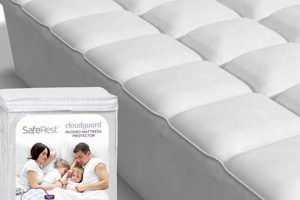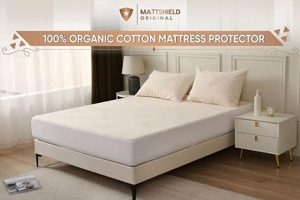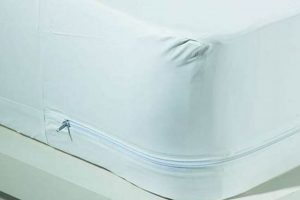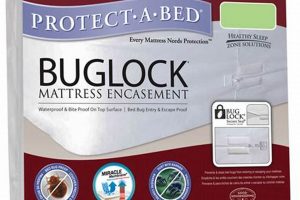A conforming bed overlay designed to enhance sleep comfort and protect mattresses is typically constructed from viscoelastic foam. This type of product is intended to be placed on top of a standard mattress, providing a cushioning layer and safeguarding the underlying mattress from spills, stains, and wear.
These protective layers offer several advantages, including improved sleep quality due to the enhanced comfort and support they provide. They also extend the life of a mattress by preventing damage. The development of these products reflects a growing consumer demand for both comfort and the preservation of bedding investments.
The ensuing discussion will delve into the specific materials used in construction, the various types available, considerations for selecting the appropriate model, and essential maintenance procedures.
Optimizing the Use of Viscoelastic Foam Bedding Protection
The following guidelines are designed to assist in maximizing the lifespan and performance of these bedding accessories.
Tip 1: Proper Initial Placement: Ensure the protective layer is correctly aligned on the mattress. An improper fit can lead to uneven wear and diminished comfort.
Tip 2: Routine Cleaning: Follow manufacturer instructions for regular cleaning. This prevents the accumulation of dust mites, allergens, and stains, thus prolonging the lifespan.
Tip 3: Utilizing a Fitted Sheet: Always cover the protective layer with a fitted sheet. This provides an additional barrier against spills and stains and enhances overall hygiene.
Tip 4: Avoiding Harsh Chemicals: Refrain from using harsh chemicals or abrasive cleaners. These can damage the viscoelastic foam and compromise its protective properties.
Tip 5: Addressing Spills Promptly: Immediately address any spills or stains. The longer a spill remains, the more difficult it will be to remove without causing damage.
Tip 6: Regular Rotation (If Applicable): Certain models may benefit from periodic rotation. Consult the manufacturer’s instructions to determine if this is recommended for the specific product.
Adherence to these recommendations will contribute to extended use, optimal hygiene, and consistent performance of your beds added protection.
Considerations for selecting replacement bedding protection are outlined in the subsequent section.
1. Water Resistance
Water resistance is a crucial attribute when evaluating a viscoelastic foam bedding protector. Its relevance stems from the inherent susceptibility of mattresses to damage from liquids, which can lead to staining, odor, and the proliferation of mold and bacteria within the mattress core.
- Barrier Against Accidental Spills
A water-resistant layer serves as the first line of defense against accidental spills, whether from beverages, bodily fluids, or other sources. By preventing liquids from penetrating the protector, it preserves the cleanliness and integrity of the underlying mattress. For instance, a protector effectively repelling a spilled glass of water can prevent permanent staining and material degradation.
- Protection Against Bedwetting
For individuals managing incontinence or households with young children, water resistance provides essential protection against bedwetting. The protector contains the liquid, preventing it from soaking into the mattress and creating unsanitary conditions. This can significantly extend the lifespan of the mattress and reduce the frequency of replacements.
- Inhibition of Microbial Growth
Moisture trapped within a mattress creates an ideal environment for the growth of mold, mildew, and bacteria. Water-resistant properties help prevent this by minimizing the absorption of liquids and promoting a drier sleep environment. This is particularly important for individuals with allergies or respiratory sensitivities, as microbial growth can exacerbate symptoms.
- Ease of Cleaning and Maintenance
Water-resistant protectors simplify the cleaning process. Spills can typically be wiped clean with a damp cloth, preventing the need for more extensive cleaning procedures. This ease of maintenance contributes to the longevity and hygienic quality of the entire sleep system.
The effectiveness of water resistance in viscoelastic foam bedding protectors is contingent on the quality of the materials and construction techniques employed. Select models integrate waterproof membranes, while others rely on tightly woven fabrics with hydrophobic properties. Regardless of the approach, water resistance remains a fundamental attribute in safeguarding the cleanliness, longevity, and hygiene of the mattress.
2. Thickness
Thickness, measured in inches or millimeters, significantly influences the performance and perceived comfort of a conforming foam mattress protector. It directly impacts its capacity to cushion, support, and protect the underlying mattress.
- Enhanced Pressure Relief
A thicker protector generally provides greater pressure relief by distributing body weight more evenly. This can be particularly beneficial for individuals experiencing joint pain or discomfort, as it reduces pressure points and promotes more restful sleep. A protector with a substantial thickness conforms more closely to the body’s contours, minimizing pressure on sensitive areas such as the hips and shoulders.
- Increased Mattress Protection
A thicker protector offers enhanced protection against spills, stains, and wear. The additional material acts as a more robust barrier, preventing liquids from penetrating the mattress and safeguarding it from physical damage. This is particularly relevant for mattresses with delicate surfaces or those susceptible to staining. The increased density provides a greater buffer against impacts and abrasions.
- Altered Sleep Surface Feel
The thickness of the protector will affect the overall feel of the sleep surface. A thicker option will noticeably soften a firmer mattress, while a thinner option will have a subtler impact. This allows consumers to fine-tune the comfort level of their mattress without investing in a completely new bed. The specific density of the foam used, in conjunction with the thickness, will determine the final feel.
- Considerations for Bed Height
The thickness of the protector should be considered in relation to the overall bed height. A particularly thick protector can significantly increase the height of the bed, potentially requiring adjustments to bedding or the use of a step stool for easier access. It is important to ensure that the added thickness does not create an uncomfortable or unsafe sleeping environment.
In summary, the thickness of a viscoelastic foam mattress protector is a critical factor influencing pressure relief, mattress protection, sleep surface feel, and overall bed height. Selecting an appropriate thickness requires careful consideration of individual needs and preferences to optimize sleep quality and mattress longevity.
3. Breathability
Breathability, in the context of viscoelastic foam mattress protectors, refers to the material’s capacity to permit air circulation and moisture vapor transmission. The inherent density of this foam can impede airflow, leading to heat retention and a potentially uncomfortable sleep environment. Insufficient breathability results in the accumulation of body heat and moisture, elevating skin temperature and promoting perspiration. This can disrupt sleep patterns, cause discomfort, and contribute to the proliferation of bacteria and allergens within the bedding. A real-world example involves an individual residing in a humid climate who experiences night sweats due to a non-breathable protector, ultimately leading to restless sleep and skin irritation.
Enhancements in breathability are achieved through various methods, including open-cell foam structures, ventilation channels, and the incorporation of moisture-wicking fabrics. Open-cell structures create interconnected pathways that facilitate airflow, while ventilation channels provide dedicated routes for heat dissipation. Moisture-wicking fabrics draw perspiration away from the body, promoting evaporation and maintaining a cooler, drier sleep surface. For instance, a protector utilizing bamboo-derived rayon demonstrates enhanced moisture-wicking capabilities, contributing to improved temperature regulation. Failure to address breathability concerns in the design and material selection of protectors can negate the benefits of pressure relief and motion isolation associated with this foam.
In conclusion, breathability constitutes a critical performance parameter for viscoelastic foam mattress protectors. Inadequate airflow leads to heat retention and moisture accumulation, compromising sleep quality and hygiene. Manufacturers address this challenge through innovative materials and designs that promote air circulation and moisture wicking. An understanding of the relationship between breathability and protector performance is essential for informed consumer decision-making, particularly for individuals residing in warm climates or those prone to night sweats. Addressing breathability is an important consideration when selecting this type of bedding accessory.
4. Hypoallergenic Properties
The integration of hypoallergenic properties into viscoelastic foam mattress protectors addresses a significant concern for individuals susceptible to allergies and sensitivities. Traditional bedding can harbor dust mites, mold, and other allergens, triggering allergic reactions and respiratory issues. The implementation of hypoallergenic features aims to mitigate these risks, creating a sleep environment less conducive to allergen proliferation. For instance, a protector infused with antimicrobial agents can inhibit the growth of mold and bacteria, common triggers for allergic responses. The effectiveness of these properties hinges on the materials used and the manufacturing processes employed.
Protectors labeled as hypoallergenic frequently utilize tightly woven fabrics that act as a barrier against dust mites. These microscopic organisms thrive in bedding and are a primary cause of allergies. Furthermore, some protectors incorporate natural latex, known for its inherent resistance to dust mites and mold. A practical application is evident in households with individuals diagnosed with asthma, where the use of a hypoallergenic protector can demonstrably reduce nighttime coughing and wheezing. The selection of a protector with documented hypoallergenic certifications from reputable organizations provides assurance of its efficacy.
While the inclusion of hypoallergenic properties offers a valuable advantage, it is crucial to acknowledge that no protector is entirely allergen-proof. Regular cleaning and maintenance are essential to maintain the effectiveness of these features. Moreover, the term “hypoallergenic” is not strictly regulated, necessitating careful scrutiny of product claims and certifications. Despite these challenges, the incorporation of hypoallergenic properties into viscoelastic foam mattress protectors represents a significant step toward creating a healthier and more comfortable sleep environment for allergy sufferers.
5. Secure Fit
A secure fit is a critical attribute for a viscoelastic foam mattress protector, influencing both its functional performance and user experience. The connection stems from the protector’s intended purpose: to provide a consistent, protective layer over the mattress. A poorly fitting protector can shift, bunch, or wrinkle, diminishing its comfort, reducing its protective capacity, and potentially accelerating its wear. Consider, for example, a protector that slides off the corners of the mattress during sleep. This not only exposes the mattress to potential spills and stains but also disrupts the sleeper’s rest due to the uneven surface.
The importance of a secure fit is further underscored by the nature of viscoelastic foam. This material, while conforming and pressure-relieving, does not inherently possess properties that prevent movement or slippage when placed atop a mattress. Therefore, design features like elasticized edges, deep pockets, or anchoring straps are crucial to maintaining the protector’s position. A protector with a robust elastic perimeter, for instance, will grip the mattress edges firmly, preventing migration even with movement throughout the night. This becomes particularly relevant for adjustable beds, where the protector must maintain its position despite changes in the mattress’s orientation.
In summary, a secure fit is not merely a cosmetic concern but a fundamental requirement for a viscoelastic foam mattress protector to function effectively. It ensures consistent protection, enhances comfort, and prolongs the life of both the protector and the underlying mattress. Design elements promoting a secure fit are, therefore, essential considerations in the selection and evaluation of these bedding accessories. The absence of a secure fit compromises the intended benefits of the protector, diminishing its overall value.
Frequently Asked Questions
The subsequent questions address common inquiries regarding the use, maintenance, and selection of these mattress accessories.
Question 1: How frequently should a viscoelastic foam mattress protector be cleaned?
Cleaning frequency depends on usage and environmental factors. As a general guideline, cleaning should occur every one to two months, or more frequently if spills or stains occur. Manufacturer instructions should be consulted for specific cleaning recommendations.
Question 2: Will a viscoelastic foam mattress protector alter the feel of the underlying mattress?
Yes, these protectors can subtly alter the feel of the mattress. Thicker protectors will generally soften the sleep surface, while thinner protectors have a minimal impact. The density of the foam also influences the overall feel.
Question 3: Are viscoelastic foam mattress protectors compatible with all mattress types?
These protectors are generally compatible with most mattress types, including innerspring, memory foam, and latex mattresses. It is crucial to select a protector size that corresponds precisely to the dimensions of the mattress.
Question 4: Can a viscoelastic foam mattress protector prevent bed bug infestations?
While a protector can provide an additional barrier, it cannot guarantee complete prevention of bed bug infestations. Regular inspection and professional pest control measures are necessary to effectively manage bed bug issues.
Question 5: How does the thickness of a viscoelastic foam mattress protector impact its performance?
Thickness influences several aspects of performance, including pressure relief, mattress protection, and overall comfort. Thicker protectors typically offer enhanced pressure relief and increased protection against spills and stains.
Question 6: Are there any specific considerations for individuals with allergies when selecting a viscoelastic foam mattress protector?
Individuals with allergies should seek protectors labeled as hypoallergenic, which typically incorporate tightly woven fabrics and antimicrobial treatments to minimize allergen accumulation. Regular cleaning is also essential.
The preceding questions and answers provide a concise overview of key aspects related to viscoelastic foam mattress protectors. Prioritizing informed decision-making will contribute to optimized sleep quality and mattress longevity.
The following section will explore advanced features and innovative technologies incorporated into these bedding accessories.
Conclusion
The preceding analysis has detailed various facets of the memory foam mattress protector, encompassing its functionality, material properties, and selection criteria. Key areas of consideration include water resistance, thickness, breathability, hypoallergenic properties, and secure fit. A comprehensive understanding of these attributes is essential for making informed decisions when selecting a protector to meet specific needs and preferences.
Ultimately, the selection of a memory foam mattress protector represents a strategic investment in both sleep hygiene and mattress longevity. Careful consideration of individual needs, coupled with a thorough assessment of product features, will contribute to enhanced sleep quality and the preservation of bedding investments. Continued advancements in materials and design may further refine the performance and benefits of these protective bedding accessories.





![Shop Best Tencel Mattress Protector [Eco-Friendly] Organic & Natural Mattress Buyer’s Guide: Non-Toxic Sleep Solutions Shop Best Tencel Mattress Protector [Eco-Friendly] | Organic & Natural Mattress Buyer’s Guide: Non-Toxic Sleep Solutions](https://mattressworldpa.com/wp-content/uploads/2025/07/th-2502-300x200.jpg)

